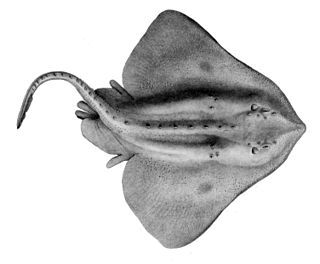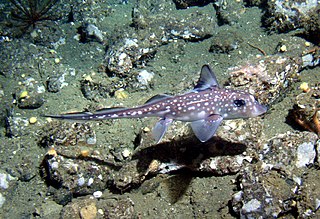
Skates are cartilaginous fish belonging to the family Rajidae in the superorder Batoidea of rays. More than 150 species have been described, in 17 genera. Softnose skates and pygmy skates were previously treated as subfamilies of Rajidae, but are now considered as distinct families. Alternatively, the name "skate" is used to refer to the entire order of Rajiformes.

The zebra shark is a species of carpet shark and the sole member of the family Stegostomatidae. It is found throughout the tropical Indo-Pacific, frequenting coral reefs and sandy flats to a depth of 62 m (203 ft). Adult zebra sharks are distinctive in appearance, with five longitudinal ridges on a cylindrical body, a low caudal fin comprising nearly half the total length, and usually a pattern of dark spots on a pale background. Young zebra sharks under 50–90 cm (20–35 in) long have a completely different pattern, consisting of light vertical stripes on a brown background, and lack the ridges. This species attains a length of 2.5 m (8.2 ft).

Chimaeras are cartilaginous fish in the order Chimaeriformes, known informally as ghost sharks, rat fish, spookfish, or rabbit fish; the last three names are not to be confused with rattails, Opisthoproctidae, or Siganidae, respectively.

The broadnose sevengill shark is the only extant member of the genus Notorynchus, in the family Hexanchidae. It is recognizable because of its seven gill slits, while most shark species have five gill slits, with the exception of the members of the order Hexanchiformes and the sixgill sawshark. This shark has a large, thick body, with a broad head and blunt snout. The top jaw has jagged, cusped teeth and the bottom jaw has comb-shaped teeth. Its single dorsal fin is set far back along the spine towards the caudal fin, and is behind the pelvic fins. In this shark the upper caudal fin is much longer than the lower, and is slightly notched near the tip. Like many sharks, this sevengill is counter-shaded. Its dorsal surface is silver-gray to brown in order to blend with the dark water and substrate when viewed from above. In counter to this, its ventral surface is very pale, blending with the sunlit water when viewed from below. The body and fins are covered in a scattering of small black & white spots. In juveniles, their fins often have white margins.

The whitespotted bamboo shark is a species of carpet shark with an adult size that approaches one metre in length. This small, mostly nocturnal species is harmless to humans. The whitespotted bamboo shark is occasionally kept as a pet in larger home aquaria. It can grow up to 93 centimetres (37 in) long.

The horn shark is a species of bullhead shark, in the family Heterodontidae. It is endemic to the coastal waters off the western coast of North America, from California to the Gulf of California. Young sharks are segregated spatially from the adults, with the former preferring deeper sandy flats and the latter preferring shallower rocky reefs or algal beds. A small species typically measuring 1 m (3.3 ft) in length, the horn shark can be recognized by a short, blunt head with ridges over its eyes, two high dorsal fins with large spines, and a brown or gray coloration with many small dark spots.
This glossary of ichthyology is a list of definitions of terms and concepts used in ichthyology, the study of fishes.
The narrownose chimaera is a longnose chimaera of the family Rhinochimaeridae, the longnose chimaeras, consisting of eight species belonging three genera. This species is found in temperate seas worldwide, at depths between 200 and 3,100 m. Its length is between 1.0 and 1.5 m, including a long, tapering snout and a long, filamentous tail.

The pelagic thresher is a species of thresher shark, family Alopiidae; this group of sharks is characterized by the greatly elongated upper lobes of their caudal fins. The pelagic thresher occurs in the tropical and subtropical waters of the Indian and Pacific Oceans, usually far from shore, but occasionally entering coastal habitats. It is often confused with the common thresher, even in professional publications, but can be distinguished by the dark, rather than white, color over the bases of its pectoral fins. The smallest of the three thresher species, the pelagic thresher typically measures 3 m (10 ft) long.

The tawny nurse shark is a species of carpet shark in the family Ginglymostomatidae, and the only extant member of the genus Nebrius.

The Japanese bullhead shark is a species of bullhead shark in the family Heterodontidae found in the northwestern Pacific Ocean off the coasts of Japan, Korea, and China. This benthic shark occurs at depths of 6–37 m (20–121 ft) over rocky bottoms or kelp beds. Measuring up to 1.2 m (3.9 ft) long, it can be identified by its short, blunt head, two high dorsal fins with anterior spines, and pattern of irregularly shaped, vertical brown bands and stripes. The Japanese bullhead shark is a docile, slow-swimming species that feeds mainly on shelled invertebrates and small bony fishes. Reproduction is oviparous, with females laying spiral-flanged eggs in communal "nests". This species is of little interest to fisheries.

The Arabian carpetshark is a species of carpet shark in the family Hemiscylliidae, inhabiting coral reefs and other shallow coastal habitats from the Persian Gulf to India. Reaching 78 cm (31 in) long, this shark is characterized by a slender, plain brown body, and by two dorsal fins with straight trailing margins and the second smaller but longer-based than the first. The Arabian carpetshark feeds on bony fishes and invertebrates. Reproduction is oviparous with an annual cycle; females deposit egg capsules four at a time and the young hatch after 70–80 days. This small shark is often captured as bycatch but rarely used by humans. It has been assessed as Near Threatened by the International Union for Conservation of Nature (IUCN), as there is increasing fishing pressure and habitat degradation within its range. It does well in aquariums and has been bred in captivity.

The spotted eagle ray is a cartilaginous fish of the eagle ray family, Aetobatidae. As traditionally recognized, it is found globally in tropical regions, including the Atlantic, Pacific and Indian Oceans. Recent authorities have restricted it to the Atlantic with other populations recognized as the ocellated eagle ray and Pacific white-spotted eagle ray. Spotted eagle rays are most commonly seen alone, but occasionally swim in groups. They are ovoviviparous, the female retaining the eggs then releasing the young as miniature versions of the parent.

Callorhinchus, the plough-nosed chimaeras or elephantfish, are the only living genus in the family Callorhinchidae. A few extinct genera only known from fossil remains are recognized. Callorhinchus spp. are similar in form and habits to other chimaeras, but are distinguished by the presence of an elongated, flexible, fleshy snout, with a vague resemblance to a ploughshare. They are only found in the oceans of the Southern Hemisphere along the ocean bottom on muddy and sandy substrates. They filter feed, with small shellfish making up the bulk of their diet. The plough-nosed chimaera lays eggs on the ocean floor that hatch at around 8 months. They are currently not a target of conservation efforts; however, they may be susceptible to overfishing and trawling.

Hydrolagus is a genus of fish in the family Chimaeridae found in the Atlantic, Indian and Pacific Oceans.

The Chimaeridae, or short-nosed chimaeras, are a family of cartilaginous fish.

The large-eyed rabbitfish is a species of fish in the family Chimaeridae. It is found in several areas of the Atlantic Ocean and within the Mediterranean Sea.

The clearnose skate is a species of cartilaginous fish in the family Rajidae. R. eglanteria is also known by other common names such as the brier skate and summer skate. Clearnose skates are easily identified by the translucent patches on either side of their snouts and their mottled dorsal surface. They are found along the Atlantic and Gulf coasts of the United States in shallow waters of the continental shelf.

The whitespot ghost shark is a chimaera species in the family Chimaeridae, which lives in parts of the Galápagos Islands in the southeast Pacific Ocean. It lives in waters with steep slopes and boulders and grows to a total length of around 40–50 cm (16–20 in).
The Galápagos ghostshark is a chimaera species in the family Chimaeridae, likely endemic to the Galápagos Islands. It was discovered by John E. McCosker in 1995 and described in 2006, scientifically named in honor of McCosker. This chimaera has a brown compressed, elongate body. The holotype and paratype of the species, both juvenile females, had a total length of 38.1 centimetres (15.0 in) and 22.7 centimetres (8.9 in), respectively. It lives in rocky habitats close to the sea floor, in waters about 395–510 metres (1,296–1,673 ft) deep. It is listed as least concern on the IUCN Red List.






















